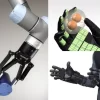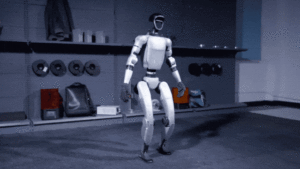On October 24, 2024, Zerith Technology launched its first bipedal humanoid robot, the Z1. Equipped with exceptional anti-interference capabilities, the Z1 can stably navigate irregular surfaces and complex terrain for extended periods. Even when subjected to high-impact forces from multiple directions, the Z1 maintains balance and remains upright.
The Z1 is powered by joint motors reaching a peak torque of 150Nm, with 27 degrees of freedom and a load-bearing limit of up to 20 kg, achieving a load-to-weight ratio exceeding 70%. The robot is integrated with an EtherCAT communication module, developed in-house by Zerith Technology, offering low-latency, high-bandwidth communication. Unique among its peers, the Z1 utilizes AI-driven design optimization for structural parameters, effectively reducing its energy consumption (COT) and enhancing dynamic motion performance. Paired with a proprietary physical interaction world model algorithm, the Z1 demonstrates superior adaptability to complex conditions and terrains, excelling in anti-interference performance.
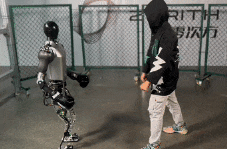
A promotional video showcases scenes reminiscent of the film Real Steel, where the robot successfully replicates complex human arm movements. According to the Zerith team, they aim to enable robotic boxing matches by year-end, achieving this without wearable controllers and allowing everyone to realize their “mecha dreams.”

Leveraging Human Video Data for Advancements in General Intelligence
The Zerith team believes that data volume is key to achieving generalized embodied intelligence, while the cost per unit of data remains a crucial factor for product scalability.
In recent years, the concept of Scaling Law has gained widespread attention. The role of large language models and Tesla’s application of Scaling Law for autonomous driving provides insights into the path to embodied intelligence. The Zerith team believes that achieving embodied intelligence, whether through multimodal large models, high-dimensional world models, or a combination of specialized smaller models, fundamentally relies on vast amounts of data. Presently, robot data requirements fall into three categories: real-world teleoperation data, high-quality synthetic simulation data, and human behavior data, the latter primarily sourced from online videos.
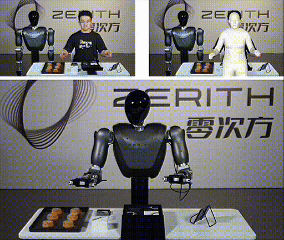
Upon rapid deployment, robots can utilize specialized scene data and internet-sourced data to train an Imaginator model. This model generates task-specific plans based on initial states and mixes generated data with real data to enhance training.
As the Imaginator improves, its reliance on real data will decrease, with generated data taking precedence. This will significantly boost algorithmic generalizability and deployment efficiency, creating a data flywheel effect. Ultimately, the Imaginator’s predictive capability will approximate real-world scenarios, embedding physics-based models that allow robots to make accurate predictions, achieving true general-purpose artificial intelligence. At that point, humanoid robots will transition from factory floors to household settings, enhancing productivity and daily living standards on a wide scale.
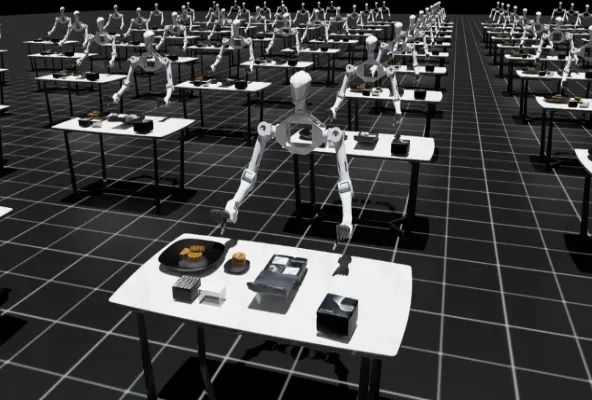
Joint Incubation by Tsinghua University and JAC Center: Two Humanoid Robots in Four Months
Founded in May of this year, Zerith Technology was co-incubated by Tsinghua University and the JAC Frontier Technology Collaborative Innovation Center.

The core team hails from the AI & Robotics Lab at Tsinghua University, with an expertise focus on robotic operation and motion control, having published extensively in leading robotics conferences and journals, including T-RO, CoRL, ICRA, and IROS. The team also includes experts from leading tech companies such as ByteDance, Baidu, and collaborative robotics companies like JAKA, bringing a wealth of experience from research to commercialization. Zerith’s founder, Min Yuheng, states, “The zeroth power of any non-zero real number is one, but the zeroth power of zero is undefined. Zerith embodies fundamental innovation, embracing boundless possibilities to achieve breakthroughs from zero to one.” In just four months, Zerith successfully developed two humanoid robot products. In addition to today’s bipedal Z1 release, the team also unveiled a dual-arm robot, F1, in mid-September.
“Post-2000” Innovators on the Rise in Humanoid Robotics
Beyond Tsinghua University, another remarkable trait defines the Zerith team: its “Post-2000” members. According to publicly available information, Zerith’s founder, Min Yuheng, is a student of the inaugural Mingyue Innovation Class at Chongqing University’s National Engineering Excellence College, later advancing to Tsinghua University.

During his undergraduate studies, Min independently developed robots with wheel-leg, bipedal, biomimetic flapping wings, and biomimetic ostrich designs. His efforts earned him multiple awards, including the National Second Prize in the National Mechanical Innovation Design Competition and a provincial First Prize in the “Internet+” Innovation and Entrepreneurship Competition. Min has also been awarded scholarships and holds six invention patents and three utility model patents. Humanoid robotics is a burgeoning field consistently attracting young entrepreneurs. In China, “Post-90s” pioneers like Wang Xingxing, Peng Zhihui, and Leng Xiaokun have become central figures in this sector, with “Post-2000s” entrepreneurs now emerging as well.
Conclusion: The humanoid robotics field, as an emerging technological frontier, is drawing an increasing number of young talents. The arrival of new innovators injects vitality into this domain, accelerating breakthroughs and expanding application scenarios. With more players entering the field, humanoid robots are expected to become a driving force in various industries in the coming years, advancing the development of intelligent technology.


